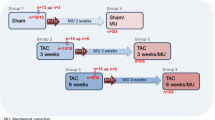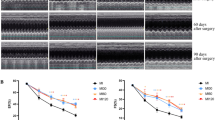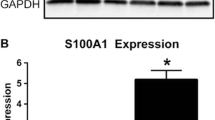Abstract
Ventricular assist devices may function as a bridge to recovery or heart transplantation, however, little is known about its mechanisms. This study examined the role of matrix metalloproteinases (MMP)-tissue inhibitors of metalloproteinases (TIMP) axis in the process of recovery after unloading in a rat ischemic-induce heart failure (HF) model. Myocardial infarction model was created with the coronary artery ligation. The infarcted rats hearts were unloaded by heterotopic cardiac transplantation (n = 14). 2 weeks later, the function of normal and infarcted hearts with or without loading was evaluated by Langendorff perfusion model. The hearts were then harvested and prepared for the study of expression of MMPs and TIMPs. Developed pressure in the unloading group was higher than the loading group (P = 0.0074). Unloading increased the ratio of TIMP-1–MMP-1(1.38 ± 0.11 vs. 0.76 ± 0.09, P < 0.05), TIMP-2–MMP-2 (1.06 ± 0.10 vs. 0.33 ± 0.07, P < 0.01), TIMP-3–MMP-9(1.07 ± 0.08 vs. 0.59 ± 0.06, P < 0.05). Although MMP-1, 2, 9 were downregulated (P < 0.01, 0.01, 0.05, respectively), TIMP-2 and TIMP-3 upregulated (P < 0.01, 0.05, respectively), MMP-7 and TIMP-1 was not affected significantly. The infarcted cardiac function could be improved by unloading. It was attributed to downregulation of MMP-1, 2 and 9, and upregulation of TIMP-2 and -3, and furthermore, the ratio of TIMPs to MMPs was increased, which might be more sensitive than sole MMPs or TIMPs for the judgment of myocardial matrix homeostasis.





Similar content being viewed by others
References
Kherani AR, Oz MC (2004) Ventricular assistance to bridge to transplantation. Surg Clin North Am 84(1):75–89 viii-ix
Spinale FG, Wilbur NM (2009) Matrix metalloproteinase therapy in heart failure. Curr Treat Options Cardiovasc Med 11(4):339–346
Brower GL, Janicki JS (2001) Contribution of ventricular remodeling to pathogenesis of heart failure in rats. Am J Physiol Heart Circ Physiol 280(2):H674–H683
Fedak PW, Verma S, Weisel RD, Li RK (2005) Cardiac remodeling and failure from molecules to man (part ii). Cardiovasc Pathol 14(2):49–60. doi:S1054-8807(05)00010-4
Fedak PW, Verma S, Weisel RD, Skrtic M, Li RK (2005) Cardiac remodeling and failure: from molecules to man (part iii). Cardiovasc Pathol 14(3):109–119
Mizuno T, Weisel RD, Li RK (2005) Reloading the heart: a new animal model of left ventricular assist device removal. J Thorac Cardiovasc Surg 130(1):99–106
Klotz S, Foronjy RF, Dickstein ML, Gu A, Garrelds IM, Danser AH, Oz MC, D’Armiento J, Burkhoff D (2005) Mechanical unloading during left ventricular assist device support increases left ventricular collagen cross-linking and myocardial stiffness. Circulation 112(3):364–374
Zhang H, Zhu SJ, Wang W, Wei YJ, Hu SS (2008) Transplantation of microencapsulated genetically modified xenogeneic cells augments angiogenesis and improves heart function. Gene Ther 15(1):40–48
Wang J, Xu R, Lin F, Zhang S, Zhang G, Hu S, Zheng Z (2009) Microrna: novel regulators involved in the remodeling and reverse remodeling of the heart. Cardiology 113(2):81–88. doi:10.1159/000172616
Zhang H, Fazel S, Tian H, Mickle DA, Weisel RD, Fujii T, Li RK (2005) Increasing donor age adversely impacts beneficial effects of bone marrow but not smooth muscle myocardial cell therapy. Am J Physiol Heart Circ Physiol 289(5):H2089–H2096. doi:289/5/H2089
Hou M, Yang KM, Zhang H, Zhu WQ, Duan FJ, Wang H, Song YH, Wei YJ, Hu SS (2007) Transplantation of mesenchymal stem cells from human bone marrow improves damaged heart function in rats. Int J Cardiol 115(2):220–228
Zhang H, Zhu SJ, Wang D, Wei YJ, Hu SS (2009) Intramyocardial injection of tannic acid attenuates postinfarction remodeling: a novel approach to stabilize the breaking extracellular matrix. J Thorac Cardiovasc Surg 137(1):216–222
Barton PJ, Birks EJ, Felkin LE, Cullen ME, Koban MU, Yacoub MH (2003) Increased expression of extracellular matrix regulators TIMP1 and MMP1 in deteriorating heart failure. J Heart Lung Transplant 22(7):738–744
Fedak PW, Moravec CS, McCarthy PM, Altamentova SM, Wong AP, Skrtic M, Verma S, Weisel RD, Li RK (2006) Altered expression of disintegrin metalloproteinases and their inhibitor in human dilated cardiomyopathy. Circulation 113(2):238–245
Felkin LE, Lara-Pezzi E, George R, Yacoub MH, Birks EJ, Barton PJ (2009) Expression of extracellular matrix genes during myocardial recovery from heart failure after left ventricular assist device support. J Heart Lung Transplant 28(2):117–122
Visse R, Nagase H (2003) Matrix metalloproteinases and tissue inhibitors of metalloproteinases: structure, function, and biochemistry. Circ Res 92(8):827–839
Spinale FG (2007) Myocardial matrix remodeling and the matrix metalloproteinases: influence on cardiac form and function. Physiol Rev 87(4):1285–1342
Sivasubramanian N, Coker ML, Kurrelmeyer KM, MacLellan WR, DeMayo FJ, Spinale FG, Mann DL (2001) Left ventricular remodeling in transgenic mice with cardiac restricted overexpression of tumor necrosis factor. Circulation 104(7):826–831
Fedak PW, Smookler DS, Kassiri Z, Ohno N, Leco KJ, Verma S, Mickle DA, Watson KL, Hojilla CV, Cruz W, Weisel RD, Li RK, Khokha R (2004) TIMP-3 deficiency leads to dilated cardiomyopathy. Circulation 110(16):2401–2409
Baba HA, Grabellus F, August C, Plenz G, Takeda A, Tjan TD, Schmid C, Deng MC (2000) Reversal of metallothionein expression is different throughout the human myocardium after prolonged left-ventricular mechanical support. J Heart Lung Transplant 19(7):668–674
Thomas CV, Coker ML, Zellner JL, Handy JR, Crumbley AJ III, Spinale FG (1998) Increased matrix metalloproteinase activity and selective upregulation in lv myocardium from patients with end-stage dilated cardiomyopathy. Circulation 97(17):1708–1715
Tessone A, Feinberg MS, Barbash IM, Reich R, Holbova R, Richmann M, Mardor Y, Leor J (2005) Effect of matrix metalloproteinase inhibition by doxycycline on myocardial healing and remodeling after myocardial infarction. Cardiovasc Drugs Ther 19(6):383–390
Peterson JT, Li H, Dillon L, Bryant JW (2000) Evolution of matrix metalloprotease and tissue inhibitor expression during heart failure progression in the infarcted rat. Cardiovasc Res 46(2):307–315
Jin B, Luo XP, Ni HC, Li Y, Shi HM (2010) Cardiac matrix remodeling following intracoronary cell transplantation in dilated cardiomyopathic rabbits. Mol Biol Rep 37(6):3037–3042
Krishnamurthy P, Peterson JT, Subramanian V, Singh M, Singh K (2009) Inhibition of matrix metalloproteinases improves left ventricular function in mice lacking osteopontin after myocardial infarction. Mol Cell Biochem 322(1–2):53–62
Wagner DR, Delagardelle C, Ernens I, Rouy D, Vaillant M, Beissel J (2006) Matrix metalloproteinase-9 is a marker of heart failure after acute myocardial infarction. J Card Fail 12(1):66–72
Li YY, Feng Y, McTiernan CF, Pei W, Moravec CS, Wang P, Rosenblum W, Kormos RL, Feldman AM (2001) Downregulation of matrix metalloproteinases and reduction in collagen damage in the failing human heart after support with left ventricular assist devices. Circulation 104(10):1147–1152
Romanic AM, Burns-Kurtis CL, Gout B, Berrebi-Bertrand I, Ohlstein EH (2001) Matrix metalloproteinase expression in cardiac myocytes following myocardial infarction in the rabbit. Life Sci 68(7):799–814
Barbone A, Holmes JW, Heerdt PM, The AH, Naka Y, Joshi N, Daines M, Marks AR, Oz MC, Burkhoff D (2001) Comparison of right and left ventricular responses to left ventricular assist device support in patients with severe heart failure: a primary role of mechanical unloading underlying reverse remodeling. Circulation 104(6):670–675
Acknowledgments
This research was supported by Grants from the Fok Ying Tung Education Foundation (121041) and National Natural Science Foundation of China (81070099).
Author information
Authors and Affiliations
Corresponding author
Additional information
Wei-jian Wang and Zi-li Meng contributed equally to this work.
Electronic supplementary material
Below is the link to the electronic supplementary material.
Rights and permissions
About this article
Cite this article
Wang, Wj., Meng, Zl., Mo, Yc. et al. Unloading the infarcted heart affect MMPs–TIMPs axis in a rat cardiac heterotopic transplantation model. Mol Biol Rep 39, 277–283 (2012). https://doi.org/10.1007/s11033-011-0736-z
Received:
Accepted:
Published:
Issue Date:
DOI: https://doi.org/10.1007/s11033-011-0736-z




